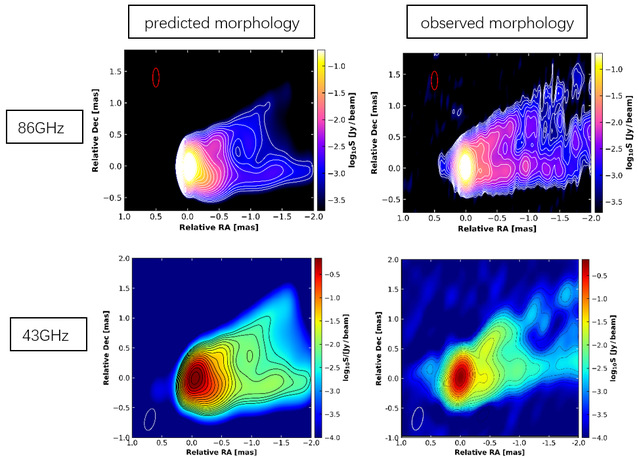An international team led by Prof. Feng YUAN investigated the validity of the two main models of black hole jets by calculating the radiation predicted by these models and comparing it with observations of the M87 jet, and found that the extraction of black hole rotational energy model accurately predicted the observed jets, while the other extraction of accretion disk rotational energy model struggled to explain the observational results. The study was published in Science Advances on March 23 (https://ui.adsabs.harvard.edu/abs/2024SciA...10N3544Y/abstract).
Black holes are extraordinarily peculiar celestial bodies in the universe, possessing an immensely powerful gravitational force that even light cannot escape within their radius, known as the event horizon. However, over a century ago, astronomers made observations revealing that just beyond the black hole's event horizon, at a very close distance, the black hole could emit powerful outflows of matter and energy at speeds approaching the speed of light – known as jets. Images captured by telescopes depict these jets shooting straight outwards, much like a laser beam, extending to vast distances, with the lengths of some jets even surpassing by far the scale of galaxies.
How these enigmatic jets form has been a question with over a century of research history. Many scholars, including Nobel laureate Penrose, have delved into this subject. Currently, in this research field, there are mainly two models. One involves extracting the rotational energy of the black hole from oversized-scale magnetic fields, known as the extraction of black hole rotational energy model. The second model also relies on large-scale magnetic fields, but unlike the first model, it involves extracting the rotational energy of the accretion disk, termed the extraction of accretion disk rotational energy model.
Regardless of which model is considered, astronomers are attempting to address only the source of energy for the jets. However, can the jets produced by these two models match the observational results regarding the morphology, width, velocity field, and polarization of the jets? Another crucial question is which of the two models for the formation mechanism of these jets is correct? The team led by Dr. YUAN Feng addressed these two questions. They found that the model involving the extraction of rotational energy from the black hole by magnetic fields accurately predicted the observed jets, while the other model struggled to explain the observational results.
The team specifically conducted their research using the jets from the supermassive black hole at the center of the M87 galaxy as a case study. This supermassive black hole is famously known as the star of the first-ever image of a black hole captured by the Event Horizon Telescope (EHT).
Initially, the research team employed large-scale numerical simulation methods to solve the equations of general relativistic magnetohydrodynamics, obtaining the accretion flow around the black hole and the jets produced by the two mechanisms mentioned above.
To calculate the radiation from the jets and compare it with observations, obtaining the energy spectrum and spatial distribution of radiating electrons was crucial. The team hypothesized that electron acceleration occurred through the magnetic reconnection mechanism in the jets. Under this assumption, they considered the physical mechanisms of magnetic reconnection accelerating electrons and combined the results of particle acceleration studies using kinetic theory to solve a steady-state electron energy distribution equation, obtaining the energy spectra and number densities of electrons in different regions of the jets.
With this information, combined with the results of numerical simulations of accretion, including magnetic field strength, gas plasma temperature, velocity, etc., they calculated the radiation transfer in the framework of general relativity to obtain various predicted observational results, which could be compared with real observations. The research results showed that the morphology of the jets predicted by the extraction of black hole rotational energy model matched the observed morphology of the jets very well. Further detailed analyses indicated that other predictions of this model, such as limb-brightening of the jets, jet width, length, velocity field, etc., also matched the observations very well. In contrast, the predictions of the extraction of accretion disk rotational energy model were inconsistent with observations (Fig. 1).

Fig. 1, The comparison between the predicted morphology of the jets based on the extraction of black hole rotational energy model and the observed morphology of the jets was presented. It can be seen from the figure that the theoretical predictions match the observations very well. Further detailed analysis indicates that other predictions of this model, such as limb-brightening of the jets, jet width, length, velocity field, etc., also match the observations very well. In contrast, the predictions of the extraction of accretion disk rotational energy model are inconsistent with observations.
In addition, the research team further analyzed the physical mechanism of magnetic reconnection and found that it (the physical mechanism of magnetic reconnection) is due to magnetic eruptions generated by the magnetic fields in the accretion disk of the M87 black hole. These eruptions can cause strong disturbances to the magnetic field, which can propagate over long distances, leading to magnetic reconnection in the jets.
This work bridges the dynamics model formed by jet formation and various properties observed in telescopic observations of jets, providing the first evidence that this well-known dynamic model not only addresses the energy issues of jets but also explains various observed results of other jets. This provides a breakthrough for our next step in understanding more unresolved mysteries near black holes.
